The Hershey Company
The Hershey Company, commonly known as Hershey's, is an American multinational company and one of the largest chocolate manufacturers in the world. It also manufactures baked products, such as cookies, cakes, milkshakes, drinks, and many more that are produced globally.[6] Its headquarters are in Hershey, Pennsylvania, which is also home to Hersheypark and Hershey's Chocolate World. It was founded by Milton S. Hershey in 1894 as the Hershey Chocolate Company, a subsidiary of his Lancaster Caramel Company. The Hershey Trust Company owns a minority stake but retains a majority of the voting power within the company.[7]
 | |
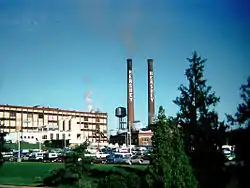 The original Hershey's chocolate factory, 1976 | |
| Hershey's | |
| Formerly |
|
| Type | Public |
| ISIN | US4278661081 |
| Industry | Food processing |
| Predecessor | Lancaster Caramel Company |
| Founded | February 8, 1894 (as Hershey Chocolate Company) in Lancaster, Pennsylvania, United States[1] |
| Founder | Milton S. Hershey |
| Headquarters | , |
Number of locations | 17 plants[2] (2020) |
Area served | Worldwide |
Key people |
|
| Products | List of products manufactured by The Hershey Company |
| Brands | |
| Revenue | |
| Total assets | |
| Total equity | |
| Owner | Hershey Trust Company (minority owner but owns the majority of the voting stock) |
Number of employees | 16,140 (Full-time) (2019) |
| Website | thehersheycompany |
Hershey's chocolate is available across the United States, and in over 60 countries worldwide.[8][9][10] They have three large distribution centers, with modern technology and labor management systems.[11] In addition, Hershey is a member of the World Cocoa Foundation. It is also associated with the Hersheypark Stadium and the Giant Center.
History
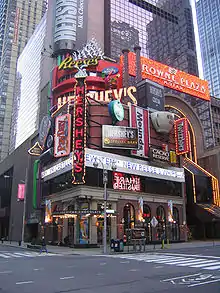
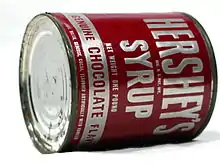
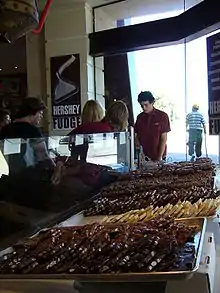
Early years
After an apprenticeship to a confectioner in 1873, Milton S. Hershey founded a candy shop in Philadelphia. This candy shop was only open for six years, after which Hershey apprenticed with another confectioner in Denver, where he learned to make caramel.[12] After another failed business attempt in New York, Hershey returned to Pennsylvania, where he founded the Lancaster Caramel Company in 1886. The use of fresh milk in caramels proved successful,[13] and in 1900, after seeing chocolate-making machines for the first time at the 1893 World's Columbian Exposition in Chicago, Hershey sold his caramel company for $1,000,000[13] (equal to $30,732,000 today), and began to concentrate on chocolate manufacturing, stating to people who questioned him, "Caramels are just a fad, but chocolate is a permanent thing."
In 1896, Hershey built a milk-processing plant so he could create and refine a recipe for his milk chocolate candies. In 1899, he developed the Hershey process, which is less sensitive to milk quality than traditional methods. In 1900, he began manufacturing Hershey's Milk Chocolate Bars, also known as Hershey's Bars or Hershey Bars.
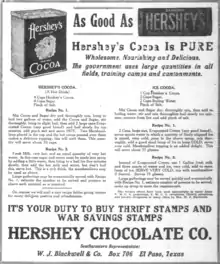
Hershey, Pennsylvania
In 1903, Hershey began construction of a chocolate plant in his hometown of Derry Church, Pennsylvania, which later came to be known as Hershey, Pennsylvania.[13] The town was an inexpensive place for the workers and their families to live; however, the factory itself was built without windows so that employees would not be distracted. To increase employee morale, Hershey provided leisure activities and created what would later become Hersheypark to make sure the citizens enjoyed themselves. The milk chocolate bars manufactured at this plant proved popular, and the company grew rapidly.
Hershey's Kisses
In 1907, he introduced a new candy - bite-sized, flat-bottomed, conical-shaped pieces of chocolate that he named "Hershey's Kiss". At first, they were individually wrapped by hand in squares of aluminum foil. The introduction of machine wrapping in 1921 simplified the process while adding the small paper ribbon to the top of the package to indicate that it was a genuine Hershey product.[13] Today, 70 million of the candies are produced daily.[14] Other products introduced included Mr. Goodbar (1925), containing peanuts in milk chocolate, Hershey's Syrup (1926), semisweet chocolate chips (1928), and the Krackel bar containing crisped rice (1938).
Reese's Peanut Butter Cups
Harry Burnett Reese invented Reese's Peanut Butter Cups after founding the H.B. Reese Candy Company in 1923.[15] Reese died on May 16, 1956 in West Palm Beach, Florida leaving the company to his six sons.[16] On July 2, 1963 the H.B. Reese Candy Company merged with the Hershey Chocolate Corporation in a tax-free stock-for-stock merger. In 2020 after 57-years of stock splits,[17] the original 666,316 shares of Hershey common stock received by the Reese family represented 16 million Hershey shares valued at $2.5 billion that pay annual cash dividends of $51.4 million.[18][19] In 1969, only 6-years after the Reese/Hershey merger, Reese's Peanut Butter Cups became The Hershey Company's top seller.[20] As of September 20, 2012, Reese's is the best-selling candy brand in the United States with sales of $2.603 billion, and is the fourth-best-selling candy brand globally with sales of $2.679 billion—only $76 million (2.8%) of its sales are from outside the United States market.[21]
Unionization
Labor unrest came to Hershey in the late 1930s as a Congress of Industrial Organizations-backed union attempted to organize the factory workers. A failed sit-down strike in 1937 ended in violence, as loyalist workers and local dairy farmers beat many of the strikers as they attempted to leave the plant. By 1940, an affiliate of the American Federation of Labor had successfully organized Hershey's workers under the leadership of John Shearer, who became the first president of Local Chapter Number 464 of the Bakery, Confectionery, Tobacco Workers and Grain Millers' International Union. Local 464 still represents the Hershey workforce.
M&M's
Shortly before World War II, Bruce Murrie, son of long-time Hershey's president William F.R. Murrie, struck a deal with Forrest Mars to create hard sugar-coated chocolate that would be called M&M's (for Mars and Murrie). Murrie had a 20% interest in the confection, which used Hershey chocolate during the rationing era during World War II. In 1948, Mars bought out Murrie's interest and became one of Hershey's main competitors.[22]
Kit Kat and Rolo
In 1969, Hershey received a license from Rowntree's to manufacture and market Kit Kat and Rolo in the United States. After Hershey's competitor Nestlé acquired Rowntree's in 1988, it was still required to honor the licensing agreement, and thus Hershey continues to make and market the brands in the U.S. The license would be revoked and revert to Nestlé if Hershey were sold.[23] It thus became a sticking point in Hershey's failed attempt to attract a serious buyer in 2002, knowing that Kit-Kat and Rolo would then have to be forfeited to Nestlé. Even Nestlé rejected Hershey's asking price feeling that the economics of such a deal did not work.[24]
Cadbury's
In 1988, Hershey's acquired the rights to manufacture and distribute many Cadbury-branded products in the United States (except gum and mints, which are part of Mondelēz International). In 2015, they sued a British importer to halt imports of British Cadbury chocolate, angering consumers.[25][26] A merger between Mondelēz and Hershey's was considered but abandoned in 2016 after Hershey's turned down a $23 billion cash-and-stock bid.[27]
Other 20th-century sales and acquisitions
In 1977, Hershey acquired Y&S Candies, founded in 1845, and became the makers of Twizzlers licorice candies.
In 1986, Hershey's began a brief foray into cough drops when it acquired the Luden's cough drops brand. By 2001, though, the brand had been sold to Pharmacia (now part of Pfizer),[28] and Luden's eventually became a product of Prestige Brands.[29] Hershey's kept Luden's 5th Avenue bar.
In 1996, Hershey purchased the American operations of the Leaf Candy Company from Huhtamäki.
In 1999, the Hershey Pasta Group was divested to several equity partners to form the New World Pasta company (now part of Ebro Foods).
21st century
On July 25, 2002, it became public knowledge that the Hershey Trust Company was seeking to sell its controlling interest in the Hershey Foods Corporation. The value of Hershey stock skyrocketed 25% with over 19 million shares trading that day. Over the following 55 days, widespread press coverage, as well as pressure from Pennsylvania Attorney General Mike Fisher, the community of Hershey, and Dauphin County Orphans' Court Senior Judge Warren G. Morgan, led to the sale being abandoned. The seven Hershey trustees who voted to sell Hershey Foods on September 17, 2002, for US$12.5 billion to the William Wrigley Jr. Company (now part of Mars Incorporated) were removed by Attorney General Fisher and Judge Morgan.[30] Ten of the 17 trustees were forced to resign and four new members who lived locally were appointed. The former Pennsylvania Attorney General, LeRoy S. Zimmerman, became the new chairman of the reconstituted Milton Hershey School Trustees. Mr. Zimmerman has publicly committed to having the Milton Hershey School Trust always retain its interest in The Hershey Company.
In December 2004, Hershey acquired the Mauna Loa Macadamia Nut Corp. from The Shansby Group.[31]
In 2005, Krave Jerky was founded by Jon Sebastiani after he trained for a marathon and looked for a healthy source of energy.[32] Alliance Consumer Growth, a private equity group, invested in Krave Jerky in 2012.[33] Hershey's purchased the company in 2015 for $240 million.[34] Hershey would later in 2020 sell Krave Jerky to Sonoma Brands, the food industry incubator founded by Jon Sebastiani in 2016.[35]
In July 2005, Hershey acquired the Berkeley, California-based boutique chocolate-maker Scharffen Berger.[36] In November 2005, Hershey acquired Joseph Schmidt Confections, the San Francisco-based chocolatier, and in November 2006, Hershey acquired Dagoba Organic Chocolate, a boutique chocolate maker based in Ashland, Oregon.
In June 2006, Philadelphia city councilman Juan Ramos called for Hershey's to stop marketing "Ice Breakers Pacs", a kind of mint, due to the resemblance of its packaging to a kind that was used for illegal street drugs.[37]
In September 2006, ABC News reported that several Hershey chocolate products were reformulated to replace cocoa butter with vegetable oil as an emulsifier. According to the company, this change was made to reduce the costs of producing the products instead of raising their prices or decreasing the sizes. Some consumers complained that the taste was different, but the company stated that in the company-sponsored blind taste tests, about half of consumers preferred the new versions. As the new versions no longer met the Food and Drug Administration's official definition of "milk chocolate", the changed items were relabeled from stating they were "milk chocolate" and "made with chocolate" to "chocolate candy" and "chocolatey."[38]
In December 2011, Hershey reached an agreement to acquire Brookside Foods Ltd., a privately held confectionery company based in Abbotsford, British Columbia.[39]
In January 2015, Hershey announced that they had acquired Krave Jerky, marking the company's first foray outside of the confectionery market in more than a decade.[40]
In April 2015, the Hershey chocolate plant on East Chocolate Avenue in Hershey Pennsylvania was demolished to make way for mixed-use development.[41]
In 2016, Hershey acquired barkTHINS, a New York-based chocolate snack foods company that expected to generate between $65 million and $75 million in revenue for that year, for $290 million.[42][34]
An August 2016 attempt to sell Hershey to Mondelez International was scuttled because of objections by the Hershey Trust.[23]
In 2017, Hershey acquired Amplify Snack Brands, Austin, Texas-based maker of SkinnyPop, in an all-cash transaction valued at approximately $1.6 billion.[43]
In September 2018, Hershey announced to buy Pirate Brands from B&G Foods for $420 million in an all-cash deal.[44][45][46]
In August 2019, Hershey announced it would purchase protein bar maker One Brands LLC for $397 million.[47]
In October 2019, Hershey's announced a collaboration with Yuengling to produce a limited release collaboration beer titled Yuengling Hershey's Chocolate Porter, becoming Hershey's first licensed beer partnership.[48]
Milton Hershey School (MHS)
Unable to have children of his own, Milton S. Hershey founded the Hershey Industrial School in 1909 for white orphaned boys.[49] In 1918, three years after the death of his wife, Milton Hershey donated around $90 million to the boarding school in trust, as well as 40% of the Hershey Company's common stock.[50] The school's initial purpose was to train young men in trades but eventually shifted to focus on preparation for college.[50] The Hershey Trust Company has exercised voting rights for the school and has been a trustee since its founding.[51]
Many of its designs resemble Hershey chocolate products, such as the Hershey Kisses street lights.[52] Milton Hershey was involved in the school's operations until his death in 1945. The Hershey Industrial School was renamed the Milton Hershey School in 1951.[53]
Manufacturing plants
The first plant outside Hershey opened on June 15, 1963, in Smiths Falls, Ontario, and the third opened on May 22, 1965, in Oakdale, California.[54] In February and April 2007, Hershey's announced that the Smiths Falls[55][56] and Oakdale[57][58] plants would close in 2008, being replaced in part by a new facility in Monterrey, Mexico. The Oakdale factory closed on February 1, 2008.[59] Hershey chocolate factory in São Roque, Brazil, was opened in August 2002. Hershey's Asia operations are largely supplied by their plant in Mandideep, India.[2]
Hershey also has plants in Stuarts Draft, Virginia; Lancaster, Pennsylvania; Hazleton, Pennsylvania; Memphis, Tennessee; Robinson, Illinois, and Guadalajara, Mexico.
Visitors to Hershey can experience Hershey's Chocolate World visitors center and its simulated tour ride. Public tours were once operated in the Pennsylvania and California factories, which ended in Pennsylvania in 1973 as soon as Hershey's Chocolate World opened,[60] and later in California following the September 11, 2001, attacks, due to security concerns.[58]
On September 18, 2012, Hershey opened a new and expanded West Hershey plant. The plant was completed at a budget of $300 million.[61]
On March 9, 2018, Hershey broke ground to expand its Kit Kat manufacturing facility in Hazle Township, Pennsylvania. The expansion project has a $60 million budget and is expected to create an additional 111 jobs at the facility.[62]
Product recalls
- In July 1998, a number of 100 g (3.5 oz) milk chocolate bars being sold for fundraising events were recalled because they may have contained traces of almonds not listed in the ingredients.[63]
- In November 2006, the Smiths Falls production plant in Ontario temporarily shut down and several products were voluntarily recalled after concerns over Salmonella contamination possibly found in soy lecithin within their production line. It was believed that most of the products involved in the recall never made it to the retail level.[64][65]
Philanthropy
Hershey has made large contributions to education. One of their most notable contributions was the Elizabethtown College Honors Program.[66] The program was established in 1999 and is funded partially through the endowment.
In 2015, Hershey announced a commitment to the Clinton Global Initiative to help build a sustainable supply chain to support basic nutrition for children in Ghana.[67]
Hershey's long-term focus on children and families has yielded long-standing partnerships with organizations such as Children's Miracle Network, Ronald McDonald House, and United Way (UW). In 2016, the company donated more than $486,200 to those organizations.[68]
Criticism
Cocoa purchase
Hershey has been criticized for not having programs to ensure sustainable and ethical cocoa purchases, lagging behind its competitors in fair trade measures.[69]
The "Raise the Bar, Hershey!" campaign was launched in September 2010 by Global Exchange, Green America, the Oasis Trust, and the International Labor Rights Forum. The purpose of the Raise the Bar Campaign was to pressure Hershey to commit "to take immediate action to eliminate forced and child labor [...] from Hershey's cocoa supply"; "to sourcing 100% Fair Trade Certified cocoa beans by 2012 for at least one of its top five selling chocolate bars [...] making at least one additional top five selling bar 100% Fair Trade Certified every two years thereafter"; and that "the majority of Hershey's cocoa across all products will be Fair Trade Certified by 2022". The pressure was particularly directed at Whole Foods Market, which announced on October 3, 2012, that it would cease carrying Hershey's Scharffen Berger line.[70] The Campaign stated, "Whole Foods' decision follows more than 40 natural food retailers and coops publicly expressing concern about carrying Scharffen Berger and Dagoba products as a consequence of the giant chocolate maker's refusal to address child labor in its supply chain".[70] The same day, Hershey's announced it would "source 100 percent certified cocoa for its global chocolate product lines by 2020 and accelerate its programs to help eliminate child labor in the cocoa regions of West Africa".[71]
In 2019, Hershey announced that they could not guarantee that their chocolate products were free from child slave labor, as they could trace only about 50% of their purchasing back to the farm level. The Washington Post noted that the commitment taken in 2001 to eradicate such practices within 4 years had not been kept, neither at the due deadline of 2005, nor within the revised deadlines of 2008 and 2010, and that the result was not likely to be achieved for 2020 either.[72]
See also
References
- Lewis, Robert. "Hershey Company". Encyclopaedia Britannica. Encyclopaedia Britannica. Retrieved July 21, 2020.
- "Plant Locations | The Hershey Company". www.thehersheycompany.com.
- "Hershey names 11-year vet Michele Buck to CEO post". Fortune.
- "HSY Company Profile & Executives - Hershey Co. - Wall Street Journal". www.wsj.com.
- "2020 Proxy Statement 2019 Annual Report" (PDF). The Hershey Company. The Hershey Company. Retrieved July 21, 2020.
- "Hershey's Products". The Hershey Company. Archived from the original on August 5, 2018. Retrieved August 22, 2018.
- "2018 Combined Proxy Statement" (PDF). The Hershey Company. March 22, 2018. Retrieved October 27, 2018.
- "Tricks and Treats (Special)". fool.com. October 26, 1999. Archived from the original on July 1, 2012. Retrieved September 26, 2012.
- Booksense.com Archived April 20, 2006, at the Wayback Machine. Retrieved June 30, 2006.
- "The Hershey Company: NYSE:HSY quotes & news - Google Finance". Retrieved August 8, 2012.
- The Supply Chain & Logistics Institute # Chris Malon, Hershey Foods. Retrieved July 3, 2006.
- "The Hershey Company Website".
- Reference For Business.com. Retrieved June 30, 2006.
- "Plant Locations | The Hershey Company". www.thehersheycompany.com. Retrieved May 28, 2020.
- "The H.B. Reese Candy Company Story". BradReeseCom. Lebanon Daily News. June 9, 1956. Retrieved October 20, 2017.
- "H.B. Reese Death Announcement". BradReeseCom. Retrieved October 20, 2017.
- "Stock Split History". The Hershey Company. Retrieved July 25, 2020.
- "The 1963 Reese/Hershey Merger Closing Agenda" (PDF). BradReeseCom. Retrieved October 20, 2017.
- "Hershey Declares Quarterly Dividends". The Hershey Company. July 23, 2020. Retrieved July 25, 2020.
- "Was it Hershey or Reese That Made Peanut Butter Cups Great?". Atlas Obscura. Retrieved October 20, 2017.
- "Snickers Surging to Top of Global Candy Race". Ad Age. Retrieved October 20, 2017.
- "Murrie, William F.R.; 1873–1950", hersheyarchives.com. Cf section "The Story of M & Ms"
- Whitten, Sarah (August 30, 2016). "Hershey stock plummets 10% after Mondelez merger crumbles". cnbc.com. Retrieved April 17, 2017.
- Sorkin, Andrew Ross (August 27, 2002). "Possible buyers, seller far apart on Hershey sale / Price and politics are obstacles". New York Times. San Francisco Chronicle. Retrieved September 16, 2020.
- Rooney, Ben (January 23, 2015). "Hershey Lawsuit Angers Fans of British Chocolate in U.S." CNN Money.
- Baker, Andrew (January 26, 2015). "Why is Hershey's Afraid of British Chocolate?". The Telegraph.
- "Mondelez abandons pursuit of U.S. chocolate maker Hershey". Reuters. August 29, 2016. Retrieved July 23, 2019.
- Hersheys.com. Retrieved September 29, 2006.
- "Luden's Home Page". Ludens.com. Retrieved September 26, 2012.
- Lewin, Tamar (November 15, 2002). "10 Board Members to Leave Hershey's Charitable Trust". The New York Times. Retrieved July 4, 2013.
- Standard and Poor's 500 Guide. The McGraw-Hill Companies, Inc. 2007. ISBN 978-0-07-147906-6.
- Columbia Business School. "Hershey Buys Jon Sebastiani's Krave Jerky". Ideas & Insights.
- Beltran, Luisa (February 4, 2015). "ACG to make more than 6x its money with Krave Jerky sale - PE Hub". PE Hub. Retrieved February 23, 2017.
- Feldman, Amy (February 21, 2017). "Brand Boys: How An Upstart Private-Equity Firm Makes 40% A Year On Gourmet Jerky And Vegan Makeup". Forbes. Retrieved February 23, 2017.
- Douglas Yu (May 4, 2020). "Hershey Sells Culinary Meat Snacks Company Krave Back To Sonoma Brands". Forbes.
- Sfgate.com. Retrieved June 30, 2006.
- Porter, Jill (December 5, 2006). "Hershey's int/drug: Kisses, disses". Philadelphia City News.
- Coffey, Laura (September 19, 2006). "Chocoholics sour on new Hershey's formula". MSNBC. Archived from the original on September 22, 2008. Retrieved June 10, 2006.
- "Hershey Reaches an Agreement to Acquire Brookside Foods Ltd" (Press release). Business Wire. December 8, 2011. Retrieved August 8, 2012.
- Strom, Stephanie (January 29, 2015). "Hershey to Buy Krave, a Maker of Jerky". The New York Times. Retrieved September 5, 2018.
- Jeff Ruppenthal (April 7, 2014). "Former Hershey Chocolate Plant Being Demolished". LancasterOnline. Retrieved May 11, 2017.
- "Hershey Acquires barkTHINS Snacking Chocolate". www.businesswire.com (Press release). Retrieved July 14, 2016.
- Schouten, Rebekah. "Food Business News". www.foodbusinessnews.net.
- Gasparro, Annie (September 12, 2018). "Hershey to Buy Pirate's Booty Maker for $420 Million". Wall Street Journal. ISSN 0099-9660. Retrieved September 13, 2018.
- "Hershey to buy cheese puffs maker Pirate Brands for $420 million". Reuters. Retrieved September 13, 2018.
- CNBC (September 12, 2018). "Hershey to buy cheese puffs maker Pirate Brands for $420 million". CNBC. Retrieved September 13, 2018.
- Fernandez, Bob. "Hershey buys maker of high-protein bar as it looks to go healthier". Philadelphia Inquirer. Retrieved August 29, 2019.
- Snider, Mike (October 1, 2019). "Beer meets chocolate in new Yuengling and Hershey's rich, chocolatey porter". USA Today. Retrieved October 2, 2019.
- Golden, Daniel (August 12, 1999). "What Were Milton Hershey's Wishes? Question Hinders His Wealthy School". Retrieved October 1, 2018.
- "Milton S. Hershey". Entrepreneur. October 8, 2008. Retrieved October 1, 2018.
- "Hershey's major shareholder pledges to keep power". Reuters. Retrieved October 1, 2018.
- "The sweet story behind Hershey, Pa". Florida Today. Retrieved October 1, 2018.
- "Milton Hershey School - AMERICAN HERITAGE". www.americanheritage.com.
- Hershey's.com. Retrieved March 10, 2008. Archived September 14, 2008, at the Wayback Machine
- "Smiths Falls will fight to keep Hershey plant open, mayor vows". Canadian Broadcasting Corporation. February 16, 2007. Retrieved September 26, 2012.
- "Hershey confirms Smiths Falls plant will close". Canadian Broadcasting Corporation. February 22, 2007. Retrieved September 26, 2012.
- "Hershey's To Close Oakdale Plant". KCRA 3 (NBC). Hearst Television, Inc. April 30, 2007. Retrieved July 20, 2011.
- Salerno, Christina (May 1, 2007). "Hershey Closing". The Modesto Bee. McClatchy Corp. Archived from the original on January 20, 2013. Retrieved July 20, 2011. Alt URL
- Salerno, Christina (February 2, 2008). "Employees get teary eyed as the last Reese's roll off Hershey line". The Modesto Bee. McClatchy Corp. Retrieved July 20, 2011.
- "Hershey Community Archives". Hersheyarchives.org. July 20, 2011. Retrieved July 20, 2011.
- "Hershey unveils expanded West plant". Lebanon Daily News. September 18, 2012. Retrieved September 26, 2012.
- O'Boyle, Bill (March 9, 2018). "Hershey breaks ground on $60M Kit Kat production line". Times Leader. Retrieved March 14, 2018.
- Health Canada Advisory. Retrieved November 13, 2006.
- "Hershey products pulled off Canadian shelves". Canadian Broadcasting Corporation. November 13, 2006. Retrieved September 26, 2012.
- "Soy not confirmed as salmonella source in Hershey recall". Canadian Broadcasting Corporation. November 17, 2006. Retrieved September 26, 2012.
- "Elizabethtown College - Honors Program". www.etown.edu.
- "Hershey Announces Clinton Global Initiative Commitment to Build a Sustainable Supply Chain to Support Basic Nutrition for Children in Ghana". The Hershey Company.
- Hershey Entertainment & Resorts. "Hershey Entertainment & Resorts Outlines Philanthropic Giving, Community Impact". www.prnewswire.com. Retrieved June 22, 2018.
- "Hershey Dominates US Market, but Lags Behind Competitors in Avoiding Forced Labor, Trafficking and Child Labor | International Labor Rights Forum". Laborrights.org. September 13, 2010. Archived from the original on October 18, 2012. Retrieved August 8, 2012.
- "Whole Foods Drops Hershey's Scharffen Berger Chocolates Over Child Labor Issues". Green America. October 3, 2012. Retrieved February 8, 2013.
- "Hershey to Source 100% Certified Cocoa by 2020". The Hershey company. October 3, 2012. Retrieved February 8, 2013.
- Whoriskey, Peter; Siegel, Rachel (June 5, 2019). "Cocoa's child laborers". The Washington Post. Retrieved September 3, 2019.
Additional sources
- Brenner, Joël Glenn (2000). The Emperors of Chocolate: Inside the Secret World of Hershey & Mars. Broadway Books. ISBN 0-7679-0457-5.
- History | The Hotel Hershey Official Hershey's chocolate and candy site
- Official Hershey corporate site
- Business data for The Hershey Company: